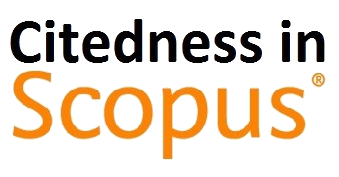GRDP Growth Rate Clustering in Surabaya City uses the K-Means Algorithm
(1) Universitas 45 Surabaya, Surabaya, Indonesia
(2) Universitas 45 Surabaya, Surabaya, Indonesia
(3) STIKOM Tunas Bangsa, Pematangsiantar, Indonesia.
(*) Corresponding Author
Abstract
Gross Regional Domestic Product (GRDP) is an indicator used to measure economic performance in a period. GRDP is the amount of added value generated by all business units in a particular area. It can also be said to be the sum of the value of the final goods and services produced by all economic units. Therefore, this study aims to cluster the GRDP Growth Rate according to business fields in the city of Surabaya, so that it is known which sectors have high or low growth. The clustering algorithm used is K-Means. By using this method, the data will b,e grouped into several clusters, where the implementation of the K-Means Clustering process uses the Rapid Miner tools. The data used is the GRDP Growth Rate in Surabaya City by Business Field, 2010-2019 (Percent). The data is divided into 3 clusters: high, medium, and low. The results obtained are nine categories/sectors with high clusters, 5 categories / sectors with medium clusters, and three categories,s / sectors with low clusters. This can be input and information for the Surabaya City government to further maximize efforts to increase the GRDP Growth Rate in the area.
Full Text:
PDFReferences
M. Muliza, “Analisis Pengaruh Jumlah Penduduk Dan Produk Domestik Regional Bruto (GRDP) Terhadap Kemiskinan Di Kabupaten Nagan Raya,” At-Tasyri’: Jurnal Ilmiah Prodi Muamalah, vol. 12, no. 1, p. 63, 2020.
S. M. AZ and S. Pebrina, “Analisis Pengaruh Tingkat Investasi, Pendapatan Asli Daerah dan Tenaga Kerja Terhadap GRDP Provinsi Jambi,” Ekonomis: Journal of Economics and Business, vol. 3, no. 1, pp. 36–43, 2019.
A. B. M. Bintang and N. Woyanti, “Pengaruh GRDP, Pendidikan, Kesehatan, Dan Pengangguran Terhadap Tingkat Kemiskinan di Jawa Tengah (2011-2015),” Media Ekonomi dan Manajemen, vol. 33, no. 1, pp. 20–28, 2018.
R. Giovanni, “Analisis Pengaruh GRDP, Pengangguran dan Pendidikan Terhadap Tingkat Kemiskinan di Pulau Jawa Tahun 2009-2016,” Economics Development Analysis Journal, vol. 7, no. 1, pp. 23–31, 2018.
I. Ummi, Rusdarti, and H. Yanto, “Relationship of the GRDP Sectors with Environmental Quality Index in Indonesia 2012-2017,” Journal of Economic Education, vol. 8, no. 2, pp. 152–158, 2019.
I. S. Damanik, A. P. Windarto, A. Wanto, Poningsih, S. R. Andani, and W. Saputra, “Decision Tree Optimization in C4.5 Algorithm Using Genetic Algorithm,” Journal of Physics: Conference Series, vol. 1255, no. 1, pp. 1–6, Aug. 2019.
W. Katrina, H. J. Damanik, F. Parhusip, D. Hartama, A. P. Windarto, and A. Wanto, “C.45 Classification Rules Model for Determining Students Level of Understanding of the Subject,” Journal of Physics: Conference Series, vol. 1255, no. 1, pp. 1–7, 2019.
H. Siahaan, H. Mawengkang, S. Efendi, A. Wanto, and A. Perdana Windarto, “Application of Classification Method C4.5 on Selection of Exemplary Teachers,” Journal of Physics: Conference Series, vol. 1235, no. 1, pp. 1–7, Jun. 2019.
I. Parlina et al., “Naive Bayes Algorithm Analysis to Determine the Percentage Level of visitors the Most Dominant Zoo Visit by Age Category,” Journal of Physics: Conference Series, vol. 1255, no. 1, pp. 1–5, 2019.
D. Hartama, A. Perdana Windarto, and A. Wanto, “The Application of Data Mining in Determining Patterns of Interest of High School Graduates,” Journal of Physics: Conference Series, vol. 1339, no. 1, pp. 1–6, 2019.
B. P. Statistik, “Laju Pertumbuhan GRDP Menurut Lapangan Usaha 2010-2019 (Persen) 2017-2019,” Badan Pusat Statistik Kota Surabaya, 2020. [Online]. Available: https://surabayakota.bps.go.id/indicator/156/204/1/laju-pertumbuhan-GRDP-menurut-lapangan-usaha-2010-2019.html. [Accessed: 10-Apr-2020].
Sudirman, A. P. Windarto, and A. Wanto, “Data mining tools | rapidminer: K-means method on clustering of rice crops by province as efforts to stabilize food crops in Indonesia,” IOP Conference Series: Materials Science and Engineering, vol. 420, no. 1, pp. 1–8, 2018.
B. Supriyadi, A. P. Windarto, T. Soemartono, and Mungad, “Classification of Natural Disaster Prone Areas in Indonesia using K-Means,” International Journal of Grid and Distributed Computing, vol. 11, no. 8, pp. 87–98, 2018.
A. S. Ahmar, D. Napitupulu, R. Rahim, R. Hidayat, Y. Sonatha, and M. Azmi, “Using K-Means Clustering to Cluster Provinces in Indonesia,” Journal of Physics: Conference Series, vol. 1028, no. 1, pp. 1–6, 2018.
Z. S. Younus et al., “Content-based image retrieval using PSO and k-means clustering algorithm,” Arabian Journal of Geosciences, vol. 8, no. 8, pp. 6211–6224, 2015.
A. Wanto et al., Data Mining : Algoritma dan Implementasi. Yayasan Kita Menulis, 2020.
E. Prasetyo, Data Mining: Konsep dan Aplikasi menggunakan Matlab. Yogyakarta: Andi Offset, 2012.
D. T. Larose, Discovering Knowledge in Data: An Introduction to Data Mining: Second Edition. New Jersey: John Wiley & Sons, 2005.
R. Primartha, Belajar Machine Learning Teori dan Praktik. Bandung: Informatika Bandung, 2018.
T. Khotimah, “Pengelompokan Surat dalam Al Qur’an menggunakan Algortima K-Means,” Jurnal Simetris, vol. 5, no. 1, pp. 83–88, 2014.
I. Parlina, A. P. Windarto, A. Wanto, and M. R. Lubis, “Memanfaatkan Algoritma K-Means dalam Menentukan Pegawai yang Layak Mengikuti Asessment Center untuk Clustering Program SDP,” CESS (Journal of Computer Engineering System and Science), vol. 3, no. 1, pp. 87–93, 2018.
DOI: https://doi.org/10.30645/ijistech.v3i2.60
Refbacks
- There are currently no refbacks.
Jumlah Kunjungan:
Published Papers Indexed/Abstracted By:












